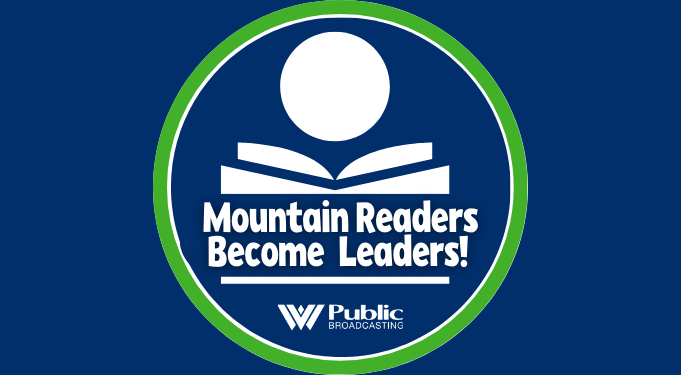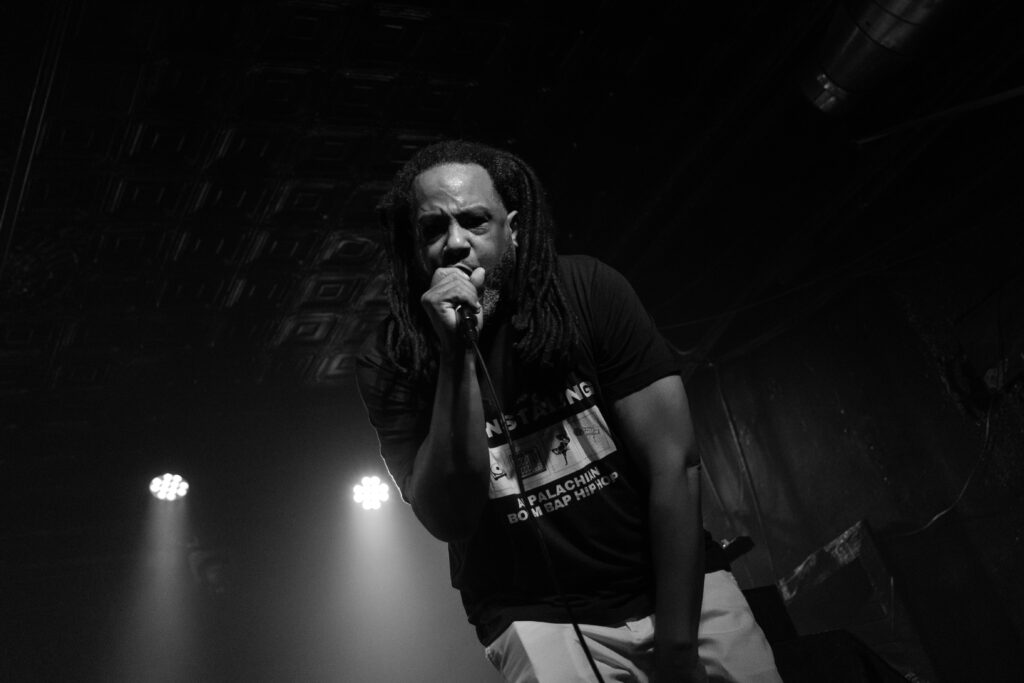Appalachian hip-hop is the subject of a new compilation from June Appal Recordings, titled No Options: Hip-Hop in Appalachia.
No Options collects 24 tracks of hip-hop from across Appalachia, showcasing the depth and breadth of the regional scene. Inside Appalachia host Mason Adams recently spoke with JK Turner, who produced the album, and Eric Jordan, also known as Monstalung, who appears on the album. Adams started by asking Monstalung how he first heard about hip-hop.
Monstalung: That would be through my cousins. When I first lived in Cleveland, Ohio, like a lot of families do, the grandmas take care of the cousins while the parents work, so we’d go over my grandmother’s house. My cousin actually lived in Cleveland, but his brothers lived in New York, and they would come from New York to Cleveland and tell us about this up-and-coming art form that they heard about. It had some dancing in it. They did artwork and this thing rapping and freestyling. When we left Cleveland and eventually moved to Anstead, West Virginia, my cousin was still making those trips in the summer, so they were coming down to Anstead, West Virginia, and giving us more detail about the culture of hip-hop. My cousins were pretty involved in all the facets. My cousin, David, he did graffiti art in his notebook, he wrote raps in his book. I was already a dancer, so breaking and stuff. I was locking before I was popping. <laughs> And that’s all we did during those summers they came down, we played athletics and went down to the park and freestyle rapped. Then once I got to college, it kept on going, but I started getting more as hip-hop started to grow. I always related to the punk scene, because the kids in the punk scene, they were going through the same thing we were going through, because hip-hop and punk came up together. We were weird kids wearing weird clothes, us and the punk kids. When I got to college, I started finding people who like DJ Jon Quick. He was a mentor of mine at Marshall University. He’s a world-renowned DJ right now, but just watching him work on his craft. The Tougher than Leather tour coming to Marshall University on Run DMC’s tour. That had a very, very big impact on me. When I committed to music, to becoming an artist, that was after I heard Tribe Called Quest’s “People’s Instinctive Travels and the Paths of Rhythm.” It was that album that I was like, “I’ve got to do this. I’ve got to learn how to make music like this.” And from that on, I was like, “All right. This is what makes me happy. This is what I love. I’m committing to that.” That was like the early ‘90s.
Adams: I think it’s interesting. You mentioned punk and hip-hop coming up together. Not only are they about the same age, but they both have an emphasis on “do it yourself.” You can start a punk band, start a hip-hop group with very little equipment or experience. So in an era where everything is accessible through the internet, and you can hear not just hip-hop from Morgantown, but hip-hop from New Orleans, the East Coast, West Coast. What distinguishes hip-hop in Appalachia?
Monstalung: The stories for sure. It’s us-against–the-world mentality. Everybody’s counting us out, or do they even know we exist? It’s finding your voice and repping for yours. When I moved back here in 1999 to do hip-hop with my brother, we made a conscious effort to like, “Let’s put it into music. Let’s give these kids something they can call their own.” We called our group 304 Recons. 304 is the area code of West Virginia back then, and we just made sure we talked about Appalachian living. We talked about trailer parks, hollers, you know. Things that’s going on in our world to give these kids something to be proud of.
Adams: JK, you worked on the No Options compilation. You’re the executive producer. How did the compilation come about? How did y’all end up working with Appalshop and putting this album together?
Turner: Yeah, that’s interesting. It was a really fun time seeing it come together. My father is Dr. William H Turner. He’s probably … actually I checked it on ChatGPT the other day. I asked ChatGPT to tell me, “Who would I go to if I wanted to talk about Black people in Appalachia?” The first three things that came up were stuff my dad had a hand in. He was the premier guy to go to for the stories of Black people in Appalachia, and their history and the culture. He and Dr. Ted Olson from East Tennessee State had a podcast. “Sepia Tones” is the name of that. It’s about the history of Black music in Appalachia. Ted’s an ethnomusicologist at East Tennessee State. As they were doing that programming together and talking about the history of Black music in Appalachia, there wasn’t much chronicled. Especially with Ted being in that genre of Appalachian music, he knew about all kinds of stuff, but didn’t know about hip-hop in Appalachia. As they started talking about it, they do, as those types of guys — lifelong academics — do, and ended up writing a grant proposal to study and to produce an album of Appalachian hip-hop music. They won that grant and were able to take the money and partner with any record label. Appalshop and June Appal Recordings was the right place to go for this sort of work. My dad has a really long history with them, going back as long as I can remember. I came into this because those two guys, Dr. Olson, Dr. Turner, are in their 70s, not as plugged into hip-hop as you might want for someone trying to put an album like this together. So from the start, they asked me to lead the way as to how to connect with people [on] social media, and what to even be listening for as we’re curating the songs, what’s right for this introductory project we’re putting together. It was a very rewarding time to work with them and put it together. Late 2022 is when everything got rolling. It’s been time well spent, and I’m glad the product is out now and people are going to be able to hear this music we put together.
Adams: Can y’all both pick out a track from the compilation and kind of shout it out? For listeners who haven’t heard it, maybe pick one track and tell us what’s compelling about it, why folks should check it out.
Monstalung: geonovah. He has two tracks on there. It’s the first track, I think it’s track four or five,
Turner: Yeah. “S&S.” Number five.
Monstalung: Whew! That production on it, the beat production, is ridiculous, but you can tell he is a master-level MC. Just his flow, his delivery, the way he’s moving in and out of the beat. When it comes to different types of forms of hip-hop, I’m foremost a boom bap artist. I’m from old-school boom bap, and that’s the vibe he gave me.
Turner: I was talking to geonovah about that track. “S&S” stands for spirits and succubus. It’s about those addiction battles that you go through. Talk about Appalachian stories, being introduced to liquor at a very young age, and you know how this can become part of your life.
Monstalung: I love it! I’m gonna steal another one. I’m sorry. JK. Sister Zock
Turner: Yeah, her track is “LOVE,” number 20. She’s actually a native New Yorker, but came to University of Tennessee, Knoxville, on a track scholarship. That was her introduction to Appalachia. She put together the Kuumba Festival in Tennessee. That was some of the first hip-hop shows they ever had at U.T.-Knoxville, were some of the shows Sista Zock put together years ago in the ‘90s. I’m glad you mentioned those two songs. I would mention the song “Show Up” from Stunna T. It’s number 23. Stunna T is actually incarcerated in Big Stone Gap. He recorded this song over the cell phone to his wife recording on the other end, and has made two full albums doing that that you can find online. We were able to get hooked up with him through June Appal, he and his wife, and had a great conversation with him, as well as some great song submissions. We were able to pick this one, and we’re real excited for him to get home in 2025 and hopefully we’ll be able to put some kind of tour together and feature him and these other artists to showcase his work.
Adams: Hip-hop is modern day folk music. I mean, just from what you all describe, you got it from other people. You got it from relatives. It was passed from person to person, and now y’all are carrying on that tradition. What does this compilation tell us about mountain hip-hop today?
Monstalung: That it’s dope.
Turner: Yeah, that’s exactly what I was gonna say. That it’s on the way up. This music is really nice. It’s so diverse, just the sounds of everything, and it’s all dope, like Eric says. It’s so many different voices. This is across states. Some states are more represented than others. Hopefully we get to do another volume and get even more artists on here. But this group we put together this time is just real nice. Some great songs, great perspectives, great storytelling.
Monstalung: We didn’t get to hear the whole project till it came out. I knew the songs that I submitted, but when I heard the actual whole album, I was blown away hearing some of these other artists from these other areas in Appalachia, I was like, “Oh, we ain’t the only dope ones in here.” It was a really good album.
Adams: What did y’all learn from this album? Is there anything you picked up along the way? Some wisdom to impart?
Monstalung: It makes me think of just how to live and how we all have to work together. We might have differences in beliefs or politics or whatever it be, especially going to this, but shows how we can all, at the end of the day in the holler, if this dude know how to work on engines, it don’t matter what color he is, that’s who we’re going to and we all work and look out for each other. It’s just these little stories. I knew we’ve had these stories, and I’ve always felt like, I know so many artists within my state alone who had these unique stories, and just to hear these other areas like that too? I was like, Appalachia’s got a lot to say.
That was West Virginia rapper Monstalung, and JK Turner, the executive producer on a new collection of Appalachian hip-hop. It’s titled No Options: Hip-Hop in Appalachia. You can also check out Adams’ interview with JK Turner’s father, William Turner, as well as Inside Appalachia’s 2021 folkways story about Big Stone Gap rapper genovah. Monstalung’s newest album is An Appalachian Hip Hop Story Pt. 1.




















